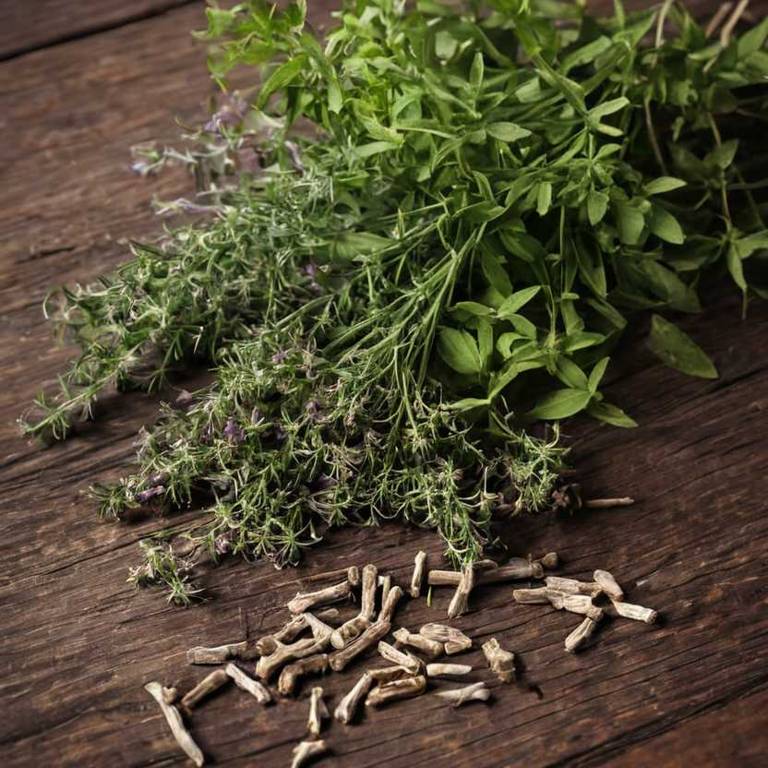By Leen Randell
Updated: Jul 20, 2024
10 Medicinal Constituents Of Glycyrrhiza Glabra (Licorice)

Glycyrrhiza glabra has active constituents such as glycyrrhizin, flavonoids, and terpenoids.
These constituents contribute to the plant's medicinal properties, including anti-inflammatory, antioxidant, and anti-ulcerative activities. The anti-inflammatory properties can help alleviate digestive issues and reduce symptoms of arthritis, improving quality of life for individuals suffering from these conditions.
Additionally, the antioxidant properties can protect against cell damage, promoting overall health and well-being.
This article explains in details the 10 best active constituents of Glycyrrhiza glabra.
1. Flavonoids
Glycyrrhiza glabra flavonoids is a type of bioactive compound extracted from its roots.
These flavonoids have been extensively studied for their potential health benefits, including anti-inflammatory and antioxidant properties.
They have been shown to exhibit antimicrobial activity against various bacteria and fungi, making them a promising area of research in the development of natural medicines.
2. Saponins
Glycyrrhiza glabra saponins is a type of triterpenoid compound found in the roots of the plant.
These saponins have been widely studied for their potential health benefits, including anti-inflammatory and antioxidant properties.
Glycyrrhizin, one of the most prominent saponins, has been shown to exhibit antimicrobial, antiviral, and immunomodulatory effects, making it a promising ingredient in traditional medicine and modern pharmaceutical applications.
3. Coumarin
Glycyrrhiza glabra coumarin is a bioactive compound derived from the root of this plant species.
It has been traditionally used in herbal medicine to treat various health conditions, including inflammation, fever, and respiratory issues. Coumarin has anticoagulant and anti-inflammatory properties, which make it effective against cardiovascular diseases and chronic pain.
Its sweet and licorice-like flavor is also used as a food additive and flavoring agent in many cuisines around the world.
4. Licochalcone a
Glycyrrhiza glabra licochalcone A is a bioactive flavonoid compound isolated from the roots of G. glabra.
It has been extensively studied for its various pharmacological activities, including anti-inflammatory, antioxidant, and antimicrobial properties.
Licochalcone A has been shown to exhibit inhibitory effects on certain enzymes and to possess cytotoxicity against certain cancer cell lines, making it a promising candidate for the treatment of various diseases.
5. Glycyrrhetinic acid
Glycyrrhiza glabra glycyrrhetinic acid is a bioactive compound extracted from its root.
It has been traditionally used in Chinese and Ayurvedic medicine for its anti-inflammatory and antioxidant properties. Glycyrrhetinic acid has been shown to have inhibitory effects on the metabolism of cortisol, leading to potential therapeutic applications in the treatment of inflammation, respiratory disorders, and skin conditions.
Additionally, it exhibits antimicrobial and antiviral activities, making it a promising compound in the development of novel therapeutics.
6. Ursolic acid
Glycyrrhiza glabra ursolic acid is a bioactive compound extracted from its root.
It has been traditionally used in various folk medicines for centuries due to its wide range of pharmacological activities. Ursolic acid has been shown to possess anti-inflammatory, antimicrobial, and antiviral properties, making it a potential therapeutic agent for treating various diseases such as cancer, diabetes, and cardiovascular disorders.
Its unique structure also allows it to interact with multiple cellular pathways, highlighting its promise in modern medicine.
7. Oleanolic acid
Glycyrrhiza glabra oleanolic acid is a triterpenoid compound extracted from its root.
It has been extensively studied for its various biological activities and potential health benefits. Oleanolic acid has been shown to exhibit anti-inflammatory, antioxidant, and anticancer properties, making it a promising natural therapeutic agent. Additionally, it has been reported to possess immunomodulatory effects, which could help in the prevention of certain diseases.
Further research is needed to fully elucidate its mechanisms of action and potential applications.
8. Quercetin
Glycyrrhiza glabra quercetin is a bioactive flavonoid compound extracted from the root of this plant.
Quercetin has been extensively studied for its antioxidant and anti-inflammatory properties, making it a popular natural remedy for various health conditions.
It has been shown to have antimicrobial, antiviral, and anticancer effects, as well as potential therapeutic benefits for cardiovascular disease, diabetes, and respiratory disorders.
9. Kaempferol
Glycyrrhiza glabra kaempferol is a flavonoid compound that has been identified in its roots and leaves.
This compound exhibits numerous biological activities, including anti-inflammatory, antioxidant, and antimicrobial properties. Kaempferol has been found to have potential therapeutic effects on various diseases, such as cancer, cardiovascular disease, and neurological disorders.
Its bioavailability and absorption are influenced by the presence of other compounds in Glycyrrhiza glabra extract.
10. Isorhapontigenin
Glycyrrhiza glabra isorhapontigenin is a bioactive compound isolated from the roots of this plant.
It has been found to possess numerous biological activities, including anti-inflammatory, antioxidant, and anticancer properties. Isorhapontigenin has been shown to inhibit the growth of certain cancer cells, suppress inflammation, and exhibit neuroprotective effects.
Its unique structure and potential therapeutic applications make it an exciting area of research in the field of phytochemistry and medicine.